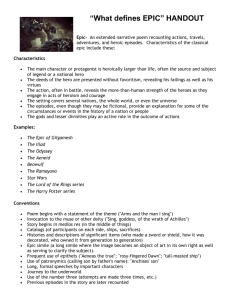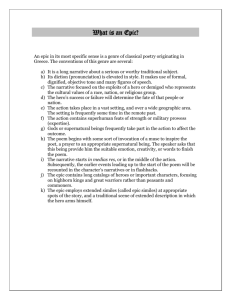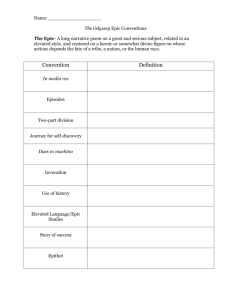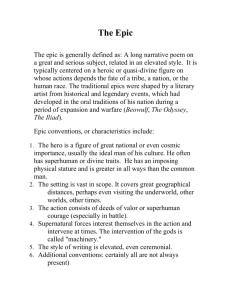Beowulf PPT
advertisement
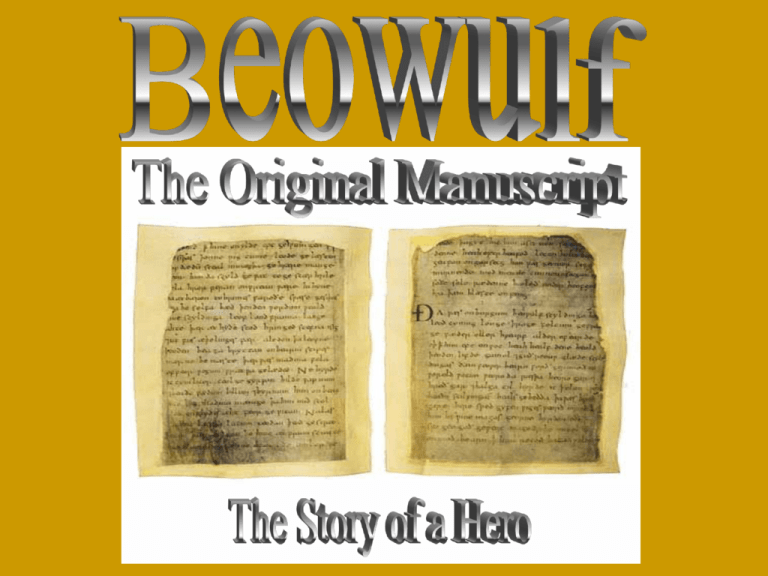
Beowulf Historical Facts • Epic poem from Anglo Saxon England • Author unknown • Written around the year 1000 • Oldest surviving medieval manuscript • Old English Poetry • Includes elegiac theme • Originated as oral myth • Based on myth, history, custom, & Christianity • Only a partial version was saved from fire • Housed in the British Library in London The British Library The British Library is the national library of the United Kingdom and one of the world's greatest libraries. It receives a copy of every publication produced in the UK and Ireland. Its collection includes 150 million items, in most known languages, and 3 million new items are incorporated every year. The British Library houses manuscripts, maps, newspapers, magazines, prints and drawings, music scores, and patents. If you saw 5 items each day, it would take you 80,000 years to see the whole of the collection. The earliest dated printed book, the Diamond Sutra, can be seen in exhibition galleries alongside many other national treasures. There is on-site space for over 1,200 readers in the library, and over 16,000 people use the collections each day. Collections at the British Library include: - Magna Carta – Lindisfarne Gospels – Leonardo da Vinci's Notebook – The Times first edition from 18 March 1788 – – Beatles manuscripts The recording of Nelson Mandela's trial speech Holdings include: – Material from 300 BC to today's newspapers – 310,000 manuscript volumes, from Jane Austen to James Joyce, Handel to the Beatles 49.5 million patents Over 4 million maps Over 260,000 journal titles – – – The building at St. Pancras Street is the largest public building constructed in the UK in the 20th century. Anglo Saxon England In the fifth century AD, people from tribes called Angles, Saxons and Jutes left their homelands in northern Europe to look for a new home. They knew that the Romans had recently left the green land of Britain unguarded, so they sailed across the channel in small wooden boats. The Britons did not give in without a fight, but after many years the invaders managed to overcome them, driving them to the west of the country. The Anglo-Saxons were to rule for over 500 years. Some objects were left behind by the Anglo-Saxons which have given us clues about how they lived. This tour gives you an introduction to that time through objects in The British Museum, home to the largest and finest AngloSaxon collection in the world. Anglo-Saxon England was a violent place where it was important to be able to defend yourself. This seax (single-bladed knife) was used both for hunting and fighting. At the Taplow burial, one of the richest finds from Anglo-Saxon times, underneath a huge grassy mound an important man was buried with possessions his followers thought he would need in the Afterlife, including this drinking horn. King Alfred 'the Great' was the most famous Anglo-Saxon king, known for being a very devout Christian and for his efforts to promote learning and literacy in a country where almost no-one could read or write. He is also famous for his success in battle against the Vikings. This is a Warlike dragon Figurehead from a small wooden ship of the Anglo-Saxon period. Anglo-Saxon England was divided into the five main kingdoms of Wessex, East Anglia, Mercia, Northumbria and Kent, each with its own king. The strongest of the kings would make the other rulers pay him tribute. Kings often died early and violent deaths. As well as fighting against each other for power, they had to keep their own nobles happy, or they might rise up against them. One way that they did this was to give them expensive presents. These rings were probably given to nobles by King Æthelwulf of Wessex. This coin was issued by Alfred some time after he took control of London. On one side is a picture of Alfred. He has been made to look like a Roman emperor. Epic Poems The Epic The epic is generally defined: A long narrative poem on a great and serious subject, related in an elevated style, and centered on a heroic or quasi-divine figure on whose actions depends the fate of a tribe, a nation, or the human race. The traditional epics were shaped by a literary artist from historical and legendary materials which had developed in the oral traditions of his nation during a period of expansion and warfare (Beowulf, The Odyssey, The Iliad). Epic Conventions, or characteristics common to both types include: * The hero is a figure of great national or even cosmic importance, usually the ideal man of his culture. He often has superhuman or divine traits. He has an imposing physical stature and is greater in all ways than the common man. * The setting is vast in scope. It covers great geographical distances, perhaps even visiting the underworld, other worlds, other times. * The action consists of deeds of valor or superhuman courage (especially in battle). * Supernatural forces interest themselves in the action and intervene at times. The intervention of the gods is called "machinery." * The style of writing is elevated, even ceremonial. • Additional conventions: certainly all are not always present) – Opens by stating the theme of the epic. – Writer invokes a Muse, one of the nine daughters of Zeus. The poet prays to the muses to provide him with divine inspiration to tell the story of a great hero. – Narrative opens in media res. This means "in the middle of things," usually with the hero at his lowest point. Earlier portions of the story appear later as flashbacks. – Catalogs and genealogies are given. These long lists of objects, places, and people place the finite action of the epic within a broader, universal context. Oftentimes, the poet is also paying homage to the ancestors of audience members. – Main characters give extended formal speeches. – Use of the epic simile. A standard simile is a comparison using "like" or "as." An epic or Homeric simile is a more involved, ornate comparison, extended in great detail. – Heavy use of repetition and stock phrases. The poet repeats passages that consist of several lines in various sections of the epic and uses Homeric epithets, short, recurrent phrases used to describe people, places, or things. Both made the poem easier to memorize. Aristotle described six characteristics: "fable, action, characters, sentiments, diction, and meter." Since then, critics have used these criteria to describe two kinds of epics: Serious Epic -fable and action are grave and solemn -characters are the highest -sentiments and diction preserve the sublime -verse Comic Epic -fable and action are light and ridiculous -characters are inferior -sentiments and diction preserve ludicrous -verse When the first novelists began writing what were later called novels, they thought they were writing "prose epics." Daniel Defoe, Henry Fielding, and Samuel Richardson attempted the comic form. Yet what they wrote were true novels, not epics, and there are differences. Serious Epic Comic Epic -oral and poetic language -written and referential language -public & remarkable deeds -historical or legendary hero -collective enterprise -generalized setting in time & place -rigid traditional structure according to previous patterns -private, daily experiencer -humanized or “ordinary” characters -individual enterprise -particularized setting in time & place -structure determined by actions of character within a moral pattern “An extended narrative poem, usually simple in construction, but grand in scope, exalted in style, and heroic in theme, often giving expression to the ideals of a nation or race. “
